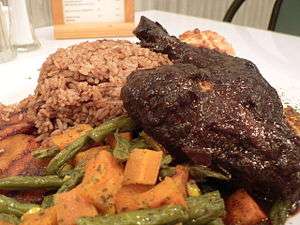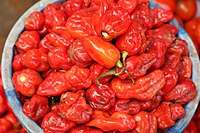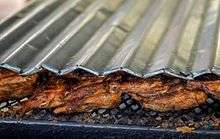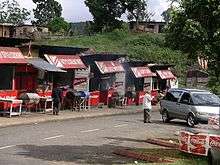Jerk (cooking)
Jerk is a style of cooking native to Jamaica, in which meat is dry-rubbed or wet marinated with a hot spice mixture called Jamaican jerk spice.


Some historians believe it was originally developed by Maroons, African slaves who escaped into the wilds of Jamaica when the British captured the island from Spain in 1655.[1][2] Adapting to their new surroundings, the former slaves made use of the natural food sources available to them, creating the spicy sauce and slowly cooking the meat over a smoking wood fire. Other historians argue that jerking originated with the Amerindians in Jamaica from the Arawak and Taino tribes who intermingled with the Maroons.[3][4]
The smoky taste of jerked meat is achieved using various cooking methods, including modern wood-burning ovens. The meat is normally chicken or pork, and the main ingredients of the spicy jerk marinade sauce are allspice[lower-alpha 1] and Scotch bonnet peppers.[5] Jerk cooking is popular in Caribbean and West Indian communities throughout North America and Western Europe.
Etymology
The word jerk is said to come from charqui, a Spanish term of Quechua origin for jerked or dried meat, which eventually became the word jerky in English.[6]
Jerk is also derived from the action of "jerking", which referred to poking meat with holes so that flavor could more easily be absorbed.[6]
The term jerk spice (also commonly known as Jamaican jerk spice) refers to a spice rub. The word jerk refers to the spice rub, wet marinade, and to the particular cooking technique. Jerk cooking has developed a global following, most notably in the United States, Canadian and Western European cosmopolitan urban centres.[7]
History
Jamaican jerk seasoning is believed to be developed by escaped enslaved Coromantee Africans in Jamaica, but historians have unearthed evidence that jerked meat was cooked by the Tainos.[8] When the British invaded Jamaica in 1655 the Spanish colonists fled, leaving behind a large number of African slaves. Rather than be re-enslaved by the British, they escaped into Jamaica's mountainous regions where they mixed in with the local Taínos.[7] It appears that these runaway slaves, who became the island's first Jamaican Maroons, learnt this practice from the Tainos.[9][10] It is speculated that while the Tainos developed the style of cooking and seasoning, the escaped African slaves introduced the marinade and the cooking pits.[11] While all racial groups hunted the wild hog in the Jamaican interior, and used the practice of jerking to cook it in the seventeenth century, by the end of the eighteenth century most groups had switched to imported pork products. Only the Maroons continued the practice of hunting wild hogs and jerking the pork.[12]
Jamaican jerk sauce primarily developed from these Maroons, seasoning and slow cooking wild hogs over pimento[lower-alpha 1] wood,[5] which was native to Jamaica at the time and is the most important ingredient in the taste; over the centuries it has been modified as various cultures added their influence.[13]
From the start, the Maroons found themselves in new surroundings on the island of Jamaica and were forced to use what was available to them.[14] As a result, they adapted to their surroundings and used herbs and spices available to them on the island such as Scotch bonnet pepper, which is largely responsible for the heat found in Caribbean jerks.[15]
Jerk cooking and seasoning has followed the Caribbean diaspora all over the world, and forms of jerk can now be found at restaurants almost anywhere a significant population of Caribbean descent exists, such as the United Kingdom, Canada, or the United States.[16] French Caribbean's poulet boucané ('smoked chicken') is quite similar to traditional Jamaican jerk chicken.[17]
Techniques

The cooking technique of jerking, as well as the results it produces, has evolved over time from using pit fires to old oil barrel halves as the containing vessel of choice.[18] Around the 1960s, Caribbean entrepreneurs seeking to recreate the smoked pit flavor by an easier, more portable method came up with a solution to cut oil barrels lengthwise and attach hinges, drilling several ventilation holes for the smoke.[18] These barrels are fired with charcoal, which enhances the spicy, smoky taste. Alternatively, when these cooking methods are unavailable, other methods of meat smoking, including wood-burning ovens, can be used to jerk meat. However, oil barrels are arguably one of the most popular cooking methods for making jerk in Jamaica. Most jerk in Jamaica is no longer cooked in the traditional method and is grilled over hardwood charcoal in a steel drum "jerk pan".[13]

Street-side "jerk stands" or "jerk centres" are frequently found in Jamaica and the nearby Cayman Islands, as well as throughout the Caribbean diaspora and beyond.[19] Jerked meat, usually chicken or pork, can be purchased along with hard dough bread, deep fried cassava bammy (flatbread, usually with fish), Jamaican fried dumplings (known as "Johnnycake" or "journey cakes"), and festival, a variation of sweet flavored fried dumplings made with sugar and served as a side.[20]
Ingredients
Jerk seasoning principally consists of allspice[lower-alpha 1] and Scotch bonnet peppers. Other ingredients may include cloves, cinnamon, scallions, nutmeg, thyme, garlic, brown sugar, ginger, and salt.
Uses
Jerk seasoning was originally used on chicken and pork, but in modern recipes it is used with other ingredients including tofu, fish, shrimp, shellfish, beef, sausage, lamb, goat and vegetables.[21]
See also
- List of Jamaican dishes
- List of chicken dishes
Notes
- Allspice is a particular species of the flowering shrub pimenta, native to the Caribbean. The Jamaican name for allspice is "pimento", due to conflation of the words pimenta and pimento. It is also called myrtle pepper.
References
- Nichols, Patrick John (2015). ""Free Negroes" – The Development of Early English Jamaica and the Birth of Jamaican Maroon Consciousness, 1655–1670". History Theses (degree thesis).
- Andrew Marshall (February 15, 2020). "The world on a plate". Vancouver Sun. p. G1.
- Michael Siva, After the Treaties: A Social, Economic and Demographic History of Maroon Society in Jamaica, 1739-1842, PhD Dissertation (Southampton: Southampton University, 2018), p. 235.
- Bev Carey, The Maroon Story: The Authentic and Original History of the Maroons in the History of Jamaica 1490-1880 (Kingston, Jamaica: Agouti Press, 1997), pp. 67-75.
- Oliver, Rochelle (July 20, 2018). "Jerk, Authentically Jamaican and Unapologetically Hot". The New York Times. Retrieved July 21, 2018.
- "The History of Jamaican Jerk". kitchenproject.com. Retrieved May 21, 2015.
- "Jerk, Charqui and the Wonders of Walkerswood". Jamaica Observer. February 12, 2015. Archived from the original on August 3, 2015. Retrieved May 30, 2016.
- Siva, After the Treaties, p. 235.
- "The History of Jamaican Jerk".
- "Jerk History ~ from the Brithplace of Jerk for Sale | Boston Jerk Center Restaurants near Port Antionio Portland, Jamaica".
- "What's the history of jerk in Caribbean cooking?". Irish Examiner. August 20, 2018.
- Siva, After the Treaties, pp. 235-6.
- Cloake, Felicity (July 11, 2012). "How to cook perfect jerk chicken". The Guardian. Archived from the original on January 14, 2016. Retrieved May 31, 2016.
- "The Africans". National Library of Jamaica. Archived from the original on January 4, 2013. Retrieved May 31, 2016.
- Bray, Matt (June 29, 2013). "Scotch Bonnet Pepper: The Caribbean Chili of Choice". Pepperscale.com. Archived from the original on March 16, 2016. Retrieved May 30, 2016.
- Glennie, Alex; Chappell, Laura (June 16, 2010). "Jamaica: From Diverse Beginning to Diaspora in the Developed World". MigrationPolicy.org. Migration Policy Institute. Archived from the original on April 20, 2016. Retrieved May 31, 2016.
- "Cuisine de la Martinique et Guadeloupe". Jamaica Observer. May 29, 2008. Archived from the original on May 30, 2016. Retrieved May 31, 2016.
- "Jamaican Jerk Chicken". Sunny Tours Jamaica. October 20, 2014. Archived from the original on August 20, 2015. Retrieved May 31, 2016.
- "Ready to Eat". Skies. Cayman Airways. January 1, 2016. Archived from the original on January 3, 2016. Retrieved May 31, 2016.
- "Jamaican Festival Recipe". Jamaica No Problem. Archived from the original on September 7, 2015. Retrieved May 31, 2016.
- Viggiano, Brooke (August 8, 2016). "Dish of the Week: Jamaican Jerk Chicken". Houston Press. Retrieved October 4, 2019.
Further reading
- Cook, Ian and Harrison, Michelle. "Cross over Food: Re-Materializing Postcolonial Geographies". Transactions of the Institute of British Geographers, New Series, Vol. 28, No. 3 (September 2003), pp. 296–317. Blackwell Publishing on behalf of The Royal Geographical Society (with the Institute of British Geographers)
- Connelly, Michael Alan (December 18, 2014). "20 Must-Try Street Foods Around the World". Fodor's. Retrieved July 24, 2016.CS1 maint: ref=harv (link)
External links
